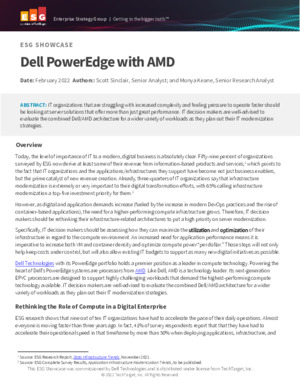Today, the level of importance of IT to a modern, digital business is absolutely clear. Fifty-nine percent of organizations surveyed by ESG now derive at least some of their revenue from information-based products and services,1 which points to the fact that IT organizations and the applications/infrastructures they support have become not just business enablers, but the prime catalyst of new revenue creation. Already, three-quarters of IT organizations say that infrastructure modernization is extremely or very important to their digital transformation efforts, with 65% calling infrastructure modernization a top-five investment priority for them.2
However, as digital and application demands increase (fueled by the increase in modern DevOps practices and the rise of container-based applications), the need for a higher-performing compute infrastructure grows. Therefore, IT decision makers should be rethinking their infrastructure-related architectures to put a high priority on server modernization.
Dell Technologies with its PowerEdge portfolio holds a premier position as a leader in compute technology. Powering the heart of Dell’s PowerEdge systems are processors from AMD. Like Dell, AMD is a technology leader. Its next-generation EPYC processors are designed to support highly challenging workloads that demand the highest-performing compute technology available. IT decision makers are well-advised to evaluate the combined Dell/AMD architecture for a wider variety of workloads as they plan out their IT modernization strategies.

